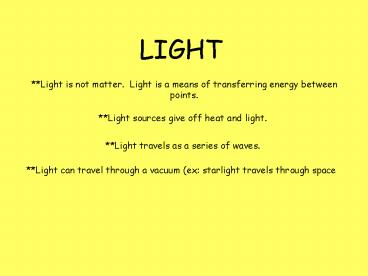LIGHT - PowerPoint PPT Presentation
1 / 13
Title:
LIGHT
Description:
Microscope an instrument used to magnify very small objects (ex: ... http://www.augusta.k12.va.us/66877372584019/lib/66877372584019/_files/SOL_5 .3_Light.doc ... – PowerPoint PPT presentation
Number of Views:34
Avg rating:3.0/5.0
Title: LIGHT
1
LIGHT
Light is not matter. Light is a means of
transferring energy between points.
Light sources give off heat and light.
Light travels as a series of waves.
Light can travel through a vacuum (ex
starlight travels through space
2
Light Instruments
- Microscope an instrument used to magnify very
small objects (ex to see cells and other living
tissue, grains of sand) - Lens a transparent material with flat, convex,
or concave spae which refracts light rays (ex
reading glasses have these) - Telescope an instrument with one eye piece lens
used to see objects far away (ex use it to look
at the night sky) - Mirror a silver coated surface which reflects
light, can be many different shapes (ex used in
cars to see other vehicles behind you)
3
Light Instruments
- Prism transparent, geometric shape (usually a
triangle) which refracts light and can create a
rainbow - Kaleidoscope a tube with mirrors inside which
reflect bits of color to make designs and
patterns (for enjoyment) - Periscope a tube with mirrors inside used to
see over or around obstacles or above water (ex
found in submarines) - Binoculars an instrument with two eye piece
lenses used to see objects far away (ex used at
sporting events, for bird watching)
4
Light Instruments Video Clips
- Binoculars and Telescope
- Microscope
- Mirrors and Lenses
- Prisms
5
Reflection when light rays bounce off a smooth
surface reflecting light Refraction when light
is bent as it travels through something refracting
light Light can be bent (refracted), bounced
(reflected), or absorbed (heats object). dark
colors absorb light and get warmer than light
objects
6
Concave (caved in) lens or mirror with middle
caved in makes objects look smaller and
sometimes upside-down concave Convex (goes out
in middle) lens or mirror goes out in
middle makes objects look larger if
close objects in distance are small and
upside-down convex
7
You must have light in order to see
anything! colored objects absorb all colors
except the one color that is reflected to your
eyes
8
R O Y G B I V
- The spectrum (rainbow) of colors
- White light is actually made of several colors
- Red color
- Orange
- Yellow
- Green
- Blue
- Violet
9
Materials can be
- Opaque no light goes through
- no words or images pass through
- Ex aluminum foil, black construction
paper) - Transparent can see words and images through it
- Ex waxed paper, window glass, transparency
film, saran wrap) - Translucent light goes through but CANNOT see
words or images - Ex most construction paper, 8 or more
layers of construction paper
10
Historical Contributions to Light
- Galileo Galilei Italian - 1564-1642
- Developed first known microscope
- first developed a refracting telescope in 1609
- Picture and information from - http//en.wikipedia
.org/wiki/Galileo_Galilei
11
Historical Contributions to Light
- Robert Hooke English 1635-1703
- discovered cells in living plant tissue using
an early compound microscope in 1665.
12
Historical Contributions to Light
- Anton van Leeuwenhoek Dutch 1632-1723
- first to observe and describe single-celled
organisms. - He created over 500 different types of
microscopes. - http//en.wikipedia.org/wiki/Anton_van_Leeuwenhoek
13
Historical Contributions to Light
- Isaac Newton English - 1642-1727
- He invented the reflecting telescope
- He discovered that when white light is passed
through a prism, it is really a combination of
colors (the spectrum). - http//en.wikipedia.org/wiki/Isaac_Newton































